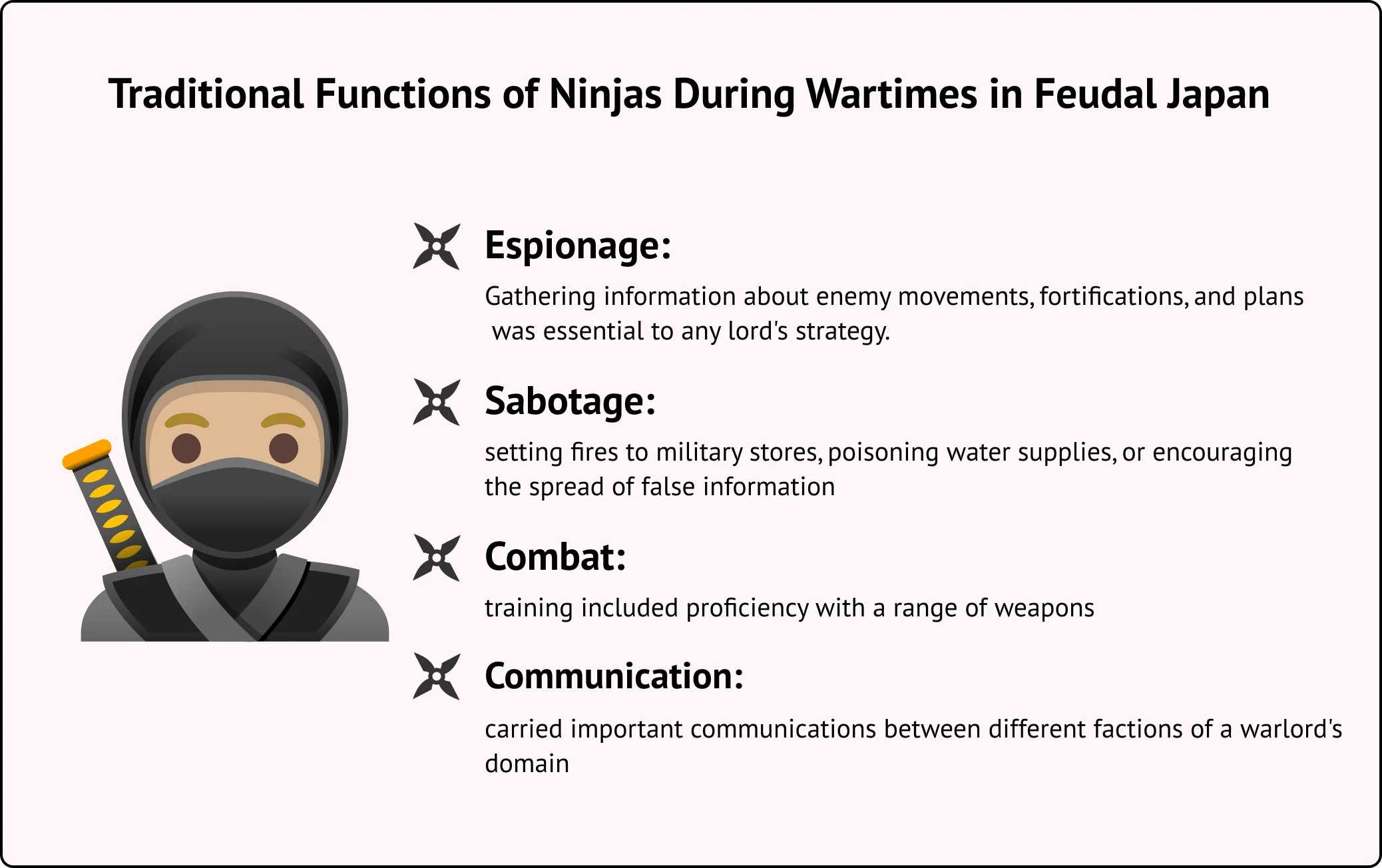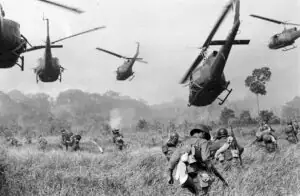Who isn’t aware of the stealthy, silent figures dressed in all black? They are hard to detect and impossible to avoid if you are one of their enemies? We all know they’re called “ninjas.” However, we rarely think about who they truly are: fictional characters created by Hollywood screenwriters or actual historical figures. Since you’re already on this page, you probably want to know more. Let’s figure this out together.

✅ AI Essay Writer ✅ AI Detector ✅ Plagchecker ✅ Paraphraser
✅ Summarizer ✅ Citation Generator
Ninjas, the stealthy operatives of feudal Japan, often evoke images of shadowy figures clad in black, leaping over castle walls in the dead of night. However, this popular portrayal is far from the historical truth. Originating in the mountainous regions of Iga and Koga, these covert agents were part of a broad socio-political environment that required intelligence and subtlety over brute force.
The charm of ninjas in modern media is undeniable, from high-flying cinema stunts to the stealth characters in video games, their portrayal is often very dramatic and cinematographic. Yet, how much of this is accurate?
 The Origin of Ninjas
The Origin of Ninjas
The concept of ninjas, or ‘shinobi’, as they were historically known, sprang from the need for intelligence and espionage during Japan’s feudal era. Initially, during the 12th century, as samurai warriors became the hands and feet of Japanese feudal lords, a need for covert operatives arose, giving birth to the ninja profession.
Rooted deeply in the provinces of Iga and Koga, these operatives came from varied backgrounds—some were dispossessed samurai, others were peasants trained to protect their villages. Their unique position in society allowed them to move across enemy lines and gather important intelligence, often tipping the balance of power during wartime.

Their development wasn’t an overnight phenomenon. Instead, it was a gradual evolution influenced by the political turbulence of the times. As local warlords fought incessantly over territorial disputes, the art of stealth and subterfuge became increasingly valued. This period, marked by the constant strife of the Sengoku (Warring States) era in the 15th to 17th centuries, saw the shinobi rise as indispensable assets.
Training in the arts of espionage was secretive and strict. The skills taught included physical combat, psychological warfare, and the ability to blend into the background, gather information, and even undertake acts of sabotage.
The ninjas’ ability to adapt and their wide range of skills were what set them apart from the typical samurai, known more for their martial prowess and strict adherence to the bushido code.
Therefore, the origin of ninjas is a response to the demands of their times—a reaction to the chaotic, often ruthless world of feudal Japan. Far from the sensationalized versions seen in today’s media, the true ninja was a product of necessity, shaped by the harsh realities of their day to perform tasks that no one else could.
 The True Role of Ninjas in Feudal Japan
The True Role of Ninjas in Feudal Japan
Often misunderstood, the role of ninjas was far more complex than the stereotypical ‘assassin in black pajamas’ concept would suggest. In the complicated society of feudal Japan, ninjas were spies, saboteurs, and sometimes messengers, functioning primarily in the shadows of great samurai wars.
Espionage
The core of ninja activities lay in espionage. Gathering information about enemy movements, fortifications, and plans was essential to any lord’s strategy. Ninjas entered enemy castles and war camps, employing a variety of disguises—often posing as monks, farmers, or even merchants. Their ability to blend in with the locals without raising suspicion was crucial, and it demonstrated their flexibility and psychological acuity.
Sabotage
Beyond spying, ninjas would engage in acts of sabotage to destabilize the enemy. This could involve setting fires to military stores, poisoning water supplies, or encouraging the spread of false information to sow conflicts and confusion. Such tactics demoralized enemies and softened defenses ahead of a major assault.

Combat
Contrary to popular belief, ninjas rarely engaged in open combat. Their training included proficiency with a range of weapons—from the iconic shuriken (throwing stars) to the less glamorous but equally effective farming tools turned weapons. However, their goal was usually to avoid detection, making the use of such weapons a last resort.
Communication
In an age where messages could be intercepted and messengers killed, the stealth and trustworthiness of ninjas made them ideal for carrying important communications between different factions or within a warlord’s domain. They used complex codes and signals to communicate, making sure that even if a message was intercepted, its meaning would remain hidden from enemy forces.
Adaptation to Civil Roles
As periods of intense warfare waned, ninjas adapted their skills for more civilian roles, including police work and private security. Their skills in observation and information gathering were highly valued in maintaining order and resolving disputes quietly and efficiently.
The real ninjas were tactical experts, valued for their brains rather than their strength. They operated under a cloak of secrecy that has since been lifted only slightly by historians. The fascination with these shadow warriors originates from their intellectual approach to warfare, which in many ways, was ahead of its time. Far from the alluring depictions in movies and comics, the life of a ninja was one of discipline, danger, and above all, discretion.
 Ninjas in Historical Records vs. Popular Culture
Ninjas in Historical Records vs. Popular Culture
The ninjas of historical records contrast sharply with the acrobatic, all-black-clad figures popularized by Hollywood and comic books. The gap between the historical ninja and their pop culture replication is significant because it reflects trends in the portrayal of historical figures in media.

That’s why it’s important to understand these distinctions for historical accuracy and appreciate the complexity of Japanese culture and the pragmatic, intelligent, and versatile operatives that ninjas truly were. The following analysis of the factual and the fictional will help you distinguish between the real image of ninjas and its pop-culture gloss.
Historical Accuracy:
- Attire: Contrary to the iconic black suits, real ninjas wore garments that helped them blend into their surroundings. This often meant peasant clothes or the attire of whatever role they were assuming undercover.
- Weapons: Historical ninjas used various tools—many improvised from farming equipment. The exaggerated arsenal of grappling hooks, swords, and shurikens commonly associated with ninjas in films is largely a modern embellishment.
- Techniques: Authentic ninja methods were about stealth and escape, not confrontation. They used techniques like smoke bombs to avoid conflict, not engage in it.
Cultural Exaggeration:
- Supernatural Skills: Modern portrayals often give ninjas almost supernatural abilities, including invisibility or superhuman agility. Historically, while ninjas were trained in stealth and espionage, their skills were rooted in practicality and intense physical training.
- Moral Ambiguity: In movies and TV shows, ninjas often appear as either noble heroes or ruthless villains. The truth is more complicated. They were pragmatic professionals who served the interests of their employers, without the clear moral alignments often depicted in pop culture.
Media Portrayals:
- Films and Television: From the James Bond franchise to animated series like “Naruto,” ninjas are often depicted as central characters with fight scenes that showcase their combat skills. These images tend to prioritize entertainment over historical accuracy.
- Video Games: Video games frequently feature ninjas as playable characters, enhancing their appeal with a range of fictional abilities. Games like “Sekiro: Shadows Die Twice” mix historical elements with fantasy, creating a compelling but heavily fictionalized version of the ninja.
 Conclusion
Conclusion
So, to respond to your question “Were ninjas real,” the answer is absolutely yes. However, as you see, their authentic historical portrayal, roles, and impact on that period in Japan starkly contrast with the stylized versions that we see in movies, cartoons, and pop culture. Whether this difference is negative depends on your personal perspective, but we believe that understanding the truth is always important even if it’s less romantic than we’d expect.
FAQ
Follow us on Reddit for more insights and updates.





Comments (0)
Welcome to A*Help comments!
We’re all about debate and discussion at A*Help.
We value the diverse opinions of users, so you may find points of view that you don’t agree with. And that’s cool. However, there are certain things we’re not OK with: attempts to manipulate our data in any way, for example, or the posting of discriminative, offensive, hateful, or disparaging material.